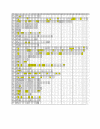The clinical course of acute otitis media in high-risk Australian Aboriginal children: a longitudinal study
- PMID: 15955251
- PMCID: PMC1177962
- DOI: 10.1186/1471-2431-5-16
The clinical course of acute otitis media in high-risk Australian Aboriginal children: a longitudinal study
Abstract
Background: It is unclear why some children with acute otitis media (AOM) have poor outcomes. Our aim was to describe the clinical course of AOM and the associated bacterial nasopharyngeal colonisation in a high-risk population of Australian Aboriginal children.
Methods: We examined Aboriginal children younger than eight years who had a clinical diagnosis of AOM. Pneumatic otoscopy and video-otoscopy of the tympanic membrane (TM) and tympanometry was done every weekday if possible. We followed children for either two weeks (AOM without perforation), or three weeks (AOM with perforation), or for longer periods if the infection persisted. Nasopharyngeal swabs were taken at study entry and then weekly.
Results: We enrolled 31 children and conducted a total of 219 assessments. Most children had bulging of the TM or recent middle ear discharge at diagnosis. Persistent signs of suppurative OM (without ear pain) were present in most children 7 days (23/30, 77%), and 14 days (20/26, 77%) later. Episodes of AOM did not usually have a sudden onset or short duration. Six of the 14 children with fresh discharge in their ear canal had an intact or functionally intact TM. Perforation size generally remained very small (<2% of the TM). Healing followed by re-perforation was common. Ninety-three nasophyngeal swabs were taken. Most swabs cultured Streptococcus pneumoniae (82%), Haemophilus influenzae (71%), and Moraxella catarrhalis (95%); 63% of swabs cultured all three pathogens.
Conclusion: In this high-risk population, AOM was generally painless and persistent. These infections were associated with persistent bacterial colonisation of the nasopharynx and any benefits of antibiotics were modest at best. Systematic follow up with careful examination and review of treatment are required and clinical resolution cannot be assumed.
Figures

Similar articles
-
Otitis media in young Aboriginal children from remote communities in Northern and Central Australia: a cross-sectional survey.BMC Pediatr. 2005 Jul 20;5:27. doi: 10.1186/1471-2431-5-27. BMC Pediatr. 2005. PMID: 16033643 Free PMC article.
-
Bacterial and viral interactions within the nasopharynx contribute to the risk of acute otitis media.J Infect. 2013 Mar;66(3):247-54. doi: 10.1016/j.jinf.2012.12.002. Epub 2012 Dec 22. J Infect. 2013. PMID: 23266462 Free PMC article.
-
Acute otitis media caused by Streptococcus pyogenes in children.Clin Infect Dis. 2005 Jul 1;41(1):35-41. doi: 10.1086/430605. Epub 2005 May 26. Clin Infect Dis. 2005. PMID: 15937760
-
The unsolved problem of otitis media in indigenous populations: a systematic review of upper respiratory and middle ear microbiology in indigenous children with otitis media.Microbiome. 2018 Nov 5;6(1):199. doi: 10.1186/s40168-018-0577-2. Microbiome. 2018. PMID: 30396360 Free PMC article.
-
Microbiology of otitis media: a moving target.Vaccine. 2008 Dec 23;26 Suppl 7:G5-10. doi: 10.1016/j.vaccine.2008.11.006. Vaccine. 2008. PMID: 19094935 Free PMC article. Review.
Cited by
-
Respiratory syncytial virus promotes Moraxella catarrhalis-induced ascending experimental otitis media.PLoS One. 2012;7(6):e40088. doi: 10.1371/journal.pone.0040088. Epub 2012 Jun 29. PLoS One. 2012. PMID: 22768228 Free PMC article.
-
Predominant Bacterial and Viral Otopathogens Identified Within the Respiratory Tract and Middle Ear of Urban Australian Children Experiencing Otitis Media Are Diversely Distributed.Front Cell Infect Microbiol. 2022 Mar 11;12:775535. doi: 10.3389/fcimb.2022.775535. eCollection 2022. Front Cell Infect Microbiol. 2022. PMID: 35360096 Free PMC article.
-
Otitis media in young Aboriginal children from remote communities in Northern and Central Australia: a cross-sectional survey.BMC Pediatr. 2005 Jul 20;5:27. doi: 10.1186/1471-2431-5-27. BMC Pediatr. 2005. PMID: 16033643 Free PMC article.
-
Predominant Bacteria Detected from the Middle Ear Fluid of Children Experiencing Otitis Media: A Systematic Review.PLoS One. 2016 Mar 8;11(3):e0150949. doi: 10.1371/journal.pone.0150949. eCollection 2016. PLoS One. 2016. PMID: 26953891 Free PMC article.
-
Otitis media: viruses, bacteria, biofilms and vaccines.Med J Aust. 2009 Nov 2;191(S9):S44-9. doi: 10.5694/j.1326-5377.2009.tb02926.x. Med J Aust. 2009. PMID: 19883356 Free PMC article.
References
-
- Glasziou PP, Del Mar CB, Sanders SL, Hayem M. Antibiotics for acute otitis media in children. Cochrane Database Syst Rev. 2005. p. CD000219. - PubMed
-
- O'Neill P, Roberts T. Acute otitis media. Clin Evid. 2004. pp. 324–337. - PubMed
-
- Leach AJ, Boswell JB, Asche V, Nienhuys TG, Mathews JD. Bacterial colonization of the nasopharynx predicts very early onset and persistence of otitis media in Australian aboriginal infants. Pediatr Infect Dis J. 1994;13:983–989. - PubMed
-
- Boswell JB, Nienhuys TG. Patterns of persistent otitis media in the first year of life in aboriginal and non-aboriginal infants. Ann Otol Rhinol Laryngol. 1996;105:893–900. - PubMed
Publication types
MeSH terms
Substances
LinkOut - more resources
Full Text Sources
Medical

